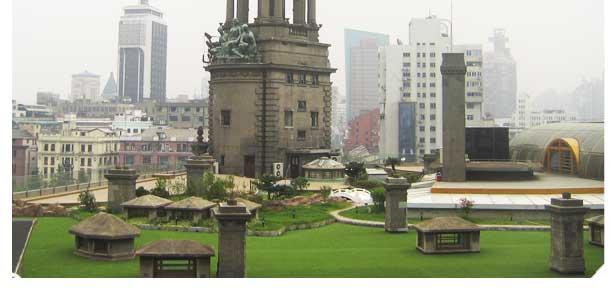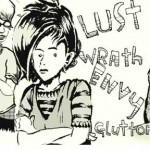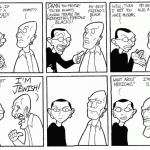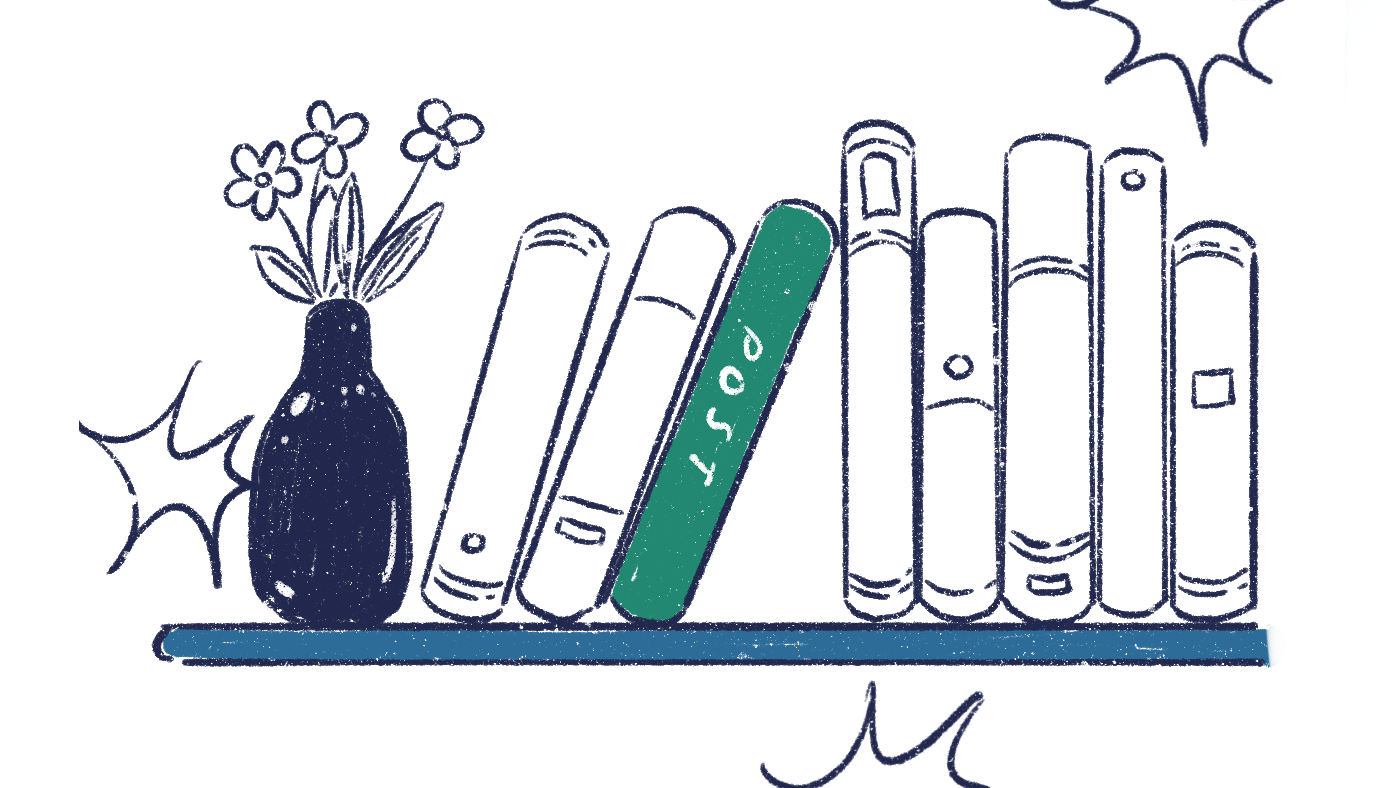Contemporary art leaps forward in Shanghai’s Studio Rouge

by Andy Cushman
On a quiet, pleasant block of Fuzhou Road along the Huangpu river in Shanghai stands a business whose existence would have been unheard of ten years ago, and would have been grounds for imprisonment as recently as twenty five years ago. It is, perhaps, the single greatest monument to a burgeoning capitalist society—a business that services few save the intellectual, the hip, and the wealthy: the contemporary art gallery.
Sitting within view of Shanghai’s glittering new skyscrapers, and mere blocks away from a shopping district where gigantic Pepsi advertisements hang from every light post like banners of an invading army, Studio Rouge stands as yet another hallmark of the new China.
I first discovered Studio Rouge while wandering somewhat aimlessly through the neighborhood around my hotel. After passing countless industrial areas and electronic component stores—themselves evoking the old China, where poor distribution required villagers to make supply runs to city centers in order to maintain machinery back home—the sight of Studio Rouge, with its slick, minimal, and still Feng Shui-friendly sign and exterior, was disorienting to say the least.
Upon entering the gallery I feel as though crossing the threshold teleports me from China to Chelsea. The gallery’s slick, almost clinically clean minimalist look is a thing almost completely unheard of here, even in the trendiest stores and clubs. I look about and large portraits of the same green truck confront me on all sides.
A young Chinese man approaches me; he is wearing a bright green and yellow striped shirt with a turntable printed on it and dog tags around his neck. Slowly, carefully, and in excellent English, he asks, “Would you like to know about the show?” I tell him I would, and he leads me around the gallery’s lower floor.
“This truck is the People’s Liberation truck,” he explains, his words punctuated by occasional breaks to consult with an electronic translator. “It was driven by Lei Feng when he would teach the people about the revolution.”
Painter Cheng Way seems to understand that the human brain interprets the radiator grills of cars and trucks the same way it does with faces, and has portrayed the truck in portraiture. The lack of descriptive imagery serves to show what a powerful image this truck has become to the Chinese people. This is not just any truck—its presence on the wall automatically denotes it as the People’s Liberation truck.
While they are all presented from the same perspective, the similarities between the portraits end there. In some, the truck appears as a friendly, almost cartoonish figure. In others, it is a nightmarish vehicle leaking blood from all cracks, its tires grinding over a mound of gore. A third truck is steely grey, cold, and aloof.
Lei Feng’s truck appears in such drastically different manners because the truck has come to mean different things from different points of view. On one hand, Lei Feng’s legacy is that of an exceptionally good, humble, and dutiful person, traditionally three of the most important characteristics one can possess in China. On the other hand, his truck — and other revolutionary symbols—has been touted by the government during times of great oppression. From the squalor and starvation of the Great Leap Forward, to the bloody Cultural Revolution, and as recent as the closed Chinese society of the 1970s, these three eras are still rarely spoken of, and are seemingly completely forbidden to the media.
My guide Andy and I continue upstairs, where a few works remaining from past shows are exhibited. “All work in this gallery is about China,” he informs me, directing me to another series of paintings from a previous show. This series presents a wall of bars, each one featuring a solitary object placed alternately on the inside or outside.
The bars, Andy explains, are representative of the old China. Inside the bars is the past, and outside of the bars, the present. In one image, an old man dressed in traditional garb is safely locked away into history. Next to it stands a similar image, only in this one a full pack of brightly packaged cigarettes becomes symbolic of recent prosperity in the form of new products. For Chinese men, who tend to be heavy smokers, cigarettes carry an added connotation of celebration that is likely lost to the Western viewer.
On other walls hang boldly colored photo collages of Mao’s silhouette. While each collage has a different theme, some featuring the propaganda theater, Chinese heroes, or a young Mao himself, the images are all representative of revolutionary history. The background of every image is composed solely of images reminiscent of the traditional, pre-commercialized China.
I ask Andy what Mao’s image represents to the Chinese youth, and he explains that Mao is history. Like the works we are viewing, he has become an image, and meaningful to them primarily in that context. It is likely a common sentiment among the Chinese youth, who, with increasing frequency, depend on revolutionary icons not for the egalitarian ideal they spark in the hearts of their elders, but in the context of entrepreneurial ventures, where young street venders furiously haggle over the price of propaganda posters with Western tourists.
“This show completely sold out,” he boasts with a shy grin.
While there is a rapidly growing demographic of young Chinese art collectors who purchase contemporary artwork both as an investment and because they find it more intellectually accessible than traditional painting, the majority of Chinese art investors are still Western collectors.
Contemporary work is relatively inexpensive here, and Studio Rouge capitalizes heavily on that fact. The gallery’s Shanghai location is also more accessible to Westerners, as China is placing an increasing emphasis on making Shanghai its next truly international city. This sentiment is echoed in the art world, and Shanghai hosted its fifth Biennial in February.
While Chinese art is becoming an international sensation, with a recent show in Switzerland displaying no less than three hundred and twenty contemporary works, it is still completely lost on your average “Jiao.” While this may seem unfortunate, the continued existence of an art scene in China depends on this fact. The government tolerates highly critical pieces only because they appeal to such a small percentage of the public.
Indeed, while seeing a story on the aforementioned Swiss show in my hotel room on CNN International, I was all too quickly reminded of how far China still has to go. The story began by describing the show’s scale, attendance, and glowing reviews. When the piece moved on to a clip of the curator describing the show’s theme, he got as far as, “the work exhibited primarily deals with Chinese society today compared with Chinese history when—before the government censor pulled the broadcast. Five minutes later, the channel’s feed returned with a report on the London underground bombing.
Incidents of a historically, internationally marginalized nation like China censoring what would normally be viewed as a moment of cultural triumph are indicative of the limits of how much Western ideology it is currently willing to accept. I am reminded of a long, government-sponsored mural I saw upon entering Beijing for the first time that essentially translated as, “a bit more freedom, a bit more democracy, a bit more tolerance, and a bit more love, leads to much more prosperity.” For the moment, however, the emphasis is on “a bit.”
But to the Chinese contemporary artists, who have faced almost constant struggle both economically and socially ever since quietly emerging from the margins after Mao’s death in 1976, “a bit more freedom” would be well compared to the “bit more oxygen” that a runner desires after entering the final lap of a thirty-year long marathon.
October 2005





















